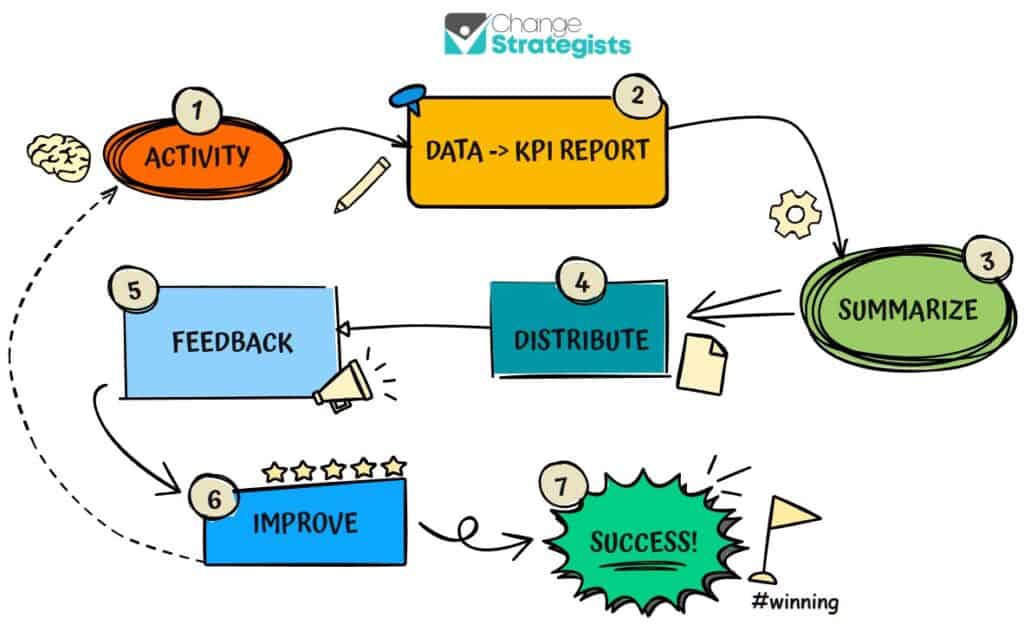Key Performance Indicators (KPIs) are an essential part of tracking how well a business is performing. KPIs can be used to measure how a business is performing on a variety of different dimensions, including financial, operational and customer satisfaction. By understanding how the company is doing on each of these fronts, managers can make informed decisions about where to focus their resources in order to improve performance. But can a KPI be negative?
While it might seem counterintuitive, a key performance indicator (KPI) can actually be negative. This is often the case when businesses are measuring something that they want to decrease, such as complaints or returns. While using KPIs with negative values isn’t always ideal, there are some benefits to doing so.
KPIs can be either positive or negative. However, businesses typically use more positive KPIs than negative ones. Positive KPIs indicate that a company is meeting its goals, while negative KPIs show areas where improvement is needed.
There are pros and cons to using both positive and negative KPIs within a business. On the one hand, negative KPIs can help flag problem areas so that they can be addressed before they become bigger issues. On the other hand, relying too heavily on negativity can create an unhealthy work environment where employees feel constantly under pressure to improve.

Ultimately, it’s up to each individual business to decide what type of KPI system works best for them. There is no right or wrong answer when it comes to choosing between positive and negative indicators; what matters most is that the chosen metrics help the company move closer towards its overall objectives.
Examples of negative KPIs that are good for business
There are some negative KPIs that can actually be good for business. Let’s take a look at a few examples.
Reduce Employee Turnover
Example: Reduce staff leaving in first year by -X%.
A high turnover rate means that the employees in your company are not happy, and they are looking for other jobs. This is bad for the company as it results in a constant cycle of hiring and training, all of which costs money.
If a company had a 50% turnover rate of staff hired in the first year (sounds high, but in the teleco industry there is a company that operated at over 100% staff turnover in the first year!) they would set a target of a -15% reduction in this rate, likely as part of a set of quarterly goals to allow changes to be implemented and take effect.
Reducing Customer Churn Rate.
Example: Reduce customer churn by -X%
Churn is the rate at which customers leave your business. Its a natural part of any business and can be a problem if it increases beyond the number of incoming new customers, because it means that you’re not attracting new customers fast enough to replace those who have left.
A high churn rate is indicative of a problem within the business. It means customers are leaving are not happy with your product or service.
As with employee turnover, setting a negative KPI, and achieving it, is beneficial to the business.
Reducing Customer Waiting Times
Example: Reduce on hold times by an average of -X minutes.
We’ve all had the misfortune to be stuck on hold at some point, and where a business fails to address an increasing number of incoming calls this can lead to very long wait times.
Call centres will usually measure departmental call handling statistics, such as time to answer. They would therefore set the teams a target of reducing the average pickup time by a certain number of minutes. The negative number of minutes is a positive outcome for customer satisfaction.
One thing all these examples have in common is that they will likely take time to address. KPI measurements should be put in place as soon as possible to establish a baseline, then when project are implimented to address each problem area, co-ordinated via the program management, the impact can be measured.
The pros and cons of using KPIs
When it comes to creating a KPI, it’s important to remember to measure the key information, more information isn’t always better.
Depending on the capabilities in place, putting KPI reporting in place can take some work, so what are the pros and cons of using them?
What are the benefits of a KPI?
Key Performance Indicators are a valuable tool to measure the success of an organization by focusing on specific goals. By having a set of measurable data points, it is possible to track if these objectives are being met. In addition, this information can help identify areas that need improvement.
1) KPIs can help you measure progress
KPIs can be a great way to track your progress and measure your success over time. By tracking specific performance indicators, you can see how well you are meeting your goals and objectives. This information can help you make improvements in your business strategy.
2) KPIs help you make informed decisions
By measuring your performance against your goals, you can determine whether your strategies are working or not. You can use this information to improve your business strategy and plan ahead.
This is especially important when managing a long term business program, it allows stakeholders to understand the impact their decisions and actions have on the business performance.
3) KPIs provide accountability
If you know that your team has been doing their job properly, you can be sure that you will get the results that you want. Accountability is one of the most powerful tools in business. When people understand that there is a clear link between their actions and the results they achieve, they tend to perform better.
4) KPIs give you insight into your customers
If you are able to collect customer feedback, you will gain valuable insights about your customers’ experience with your products or services. These insights can help you create new products or services that meet your customers’ needs.
By understanding what is happening in the customer journey, and your business in general, you can identify where there are areas of weakness and you can better focus on improvement.
When used correctly, KPIs provide a valuable way to measure the success of an organization by focusing on specific goals. They can also help identify areas that need improvement. To be effective though, it is important that they are relevant to the business and easy to understand.
What are the drawbacks of a KPI?
While KPIs offer many advantages, they also have a few drawbacks.
Too Much Information
Using too many KPIs can lead to confusion. It becomes difficult to know where to focus attention. In addition, managers spend too much time trying to interpret the results.
This means that they miss out on opportunities to improve their performance.
So, should you use KPIs? The answer depends on whether you want to make good decisions or simply collect lots of numbers. If you’re looking to make better decisions, then you need accurate information.
Bad KPIs lead to bad decision making
The best KPIs are those that are accurate, relevant, and easily understood. They allow you to make informed decisions and take action.
However if a business focuses on the wrong metrics they’ll be making decisions based on bad data. For example, if you put in place performance based short-term KPIs you might find they become irrelevant after a few months or even weeks.
Long-term success is not correlated with these numbers, and in fact, it’s often counterintuitive to pursue short-term gains at the expense of long-term growth.
KPIs are binary
KPI’s are always binary, meaning that they can only have two possible values: either they are meeting the desired results or they are not. This makes it easy to track progress and ensure that objectives are being met.
However, it can also be difficult to understand when a KPI is no longer measuring up and needs to be re-evaluated.
As it can only measure success or failure it cannot provide nuanced information about performance. As a result, decision-makers may not be able to make the most accurate decisions possible based on data from KPIs.
It can be difficult and time-consuming to create useful KPIs
While the end result should provide decision makers with easy to understand metrics, actually putting in place the systems required to monitor and generate the reports can be time-consuming and expensive to develop and maintain.
If you’re unable to systemise the process they can require significant manual effort to track and analyze, which can divert attention from more important tasks.
Additionally, if changes are made to the business process being measured, the KPIs may no longer be accurate. This necessitates regular monitoring and adjustment of KPIs to ensure that they continue to reflect reality accurately.
How can a KPI be used effectively?
A KPI, or key performance indicator, is a valuable tool that can be used in nearly any part of a business. By tracking and monitoring KPIs, businesses can measure the success (or failure) of their operations and make necessary changes to improve their productivity.

There are two important things to remember about KPIs: first, they must be relevant to the department responsible for tracking them; secondly, they must be tracked on a regular basis in order to be effective.
KPIs can also be used to measure the efficiency of an individual or team. This information can then be used to help improve their productivity and maximize their output. In short, KPIs are an essential tool for measuring success in any organization.
How can a KPI be used to improve performance?
Now you know what they are and what the pros and cons are, let’s consider how they can be used to help your business grow.
I think it’s important at this point to flag that having data doesn’t in itself magically resolve problems, and having too much data can create issues, or analysis paralysis as it is sometimes know.
Management can become so obsessed with the numbers that it distracts them from trying to achieve the accompanying goal. And at an individual level you sometimes find staff ‘working the system’ to manipulate figures to make all indicators look good to management.
That being said, there are a number of ways that a KPI can be used to improve performance. One way is to use it as a metric for measuring progress or achievement. For example, if you are looking to increase sales, you could track how many units were sold each month using a KPI. This would allow you to see how well your team is doing and whether they are making any progress in reaching their goals.
Another way that a KPI can be used to improve performance is by driving improvement through goal setting. When creating goals, it is important to specify what the goal should achieve and how it should be measured. This will help ensure that the goals are achievable and provide guidance on where additional effort may be necessary. Once the goals have been set, using a KPI can help measure progress towards these objectives and identify areas where further improvement is needed.

Finally, a KPI can also be used to determine when an organization has reached its target state or achieved its desired outcome. By tracking key performance indicators over time, managers can identify when an organization has reached its target state or achieved its desired outcome and make adjustments accordingly. This information can help organizations stay ahead of changes in the market and maintain their competitive edge.
What are some common mistakes with KPIs?
There are a few common mistakes that people make when it comes to KPIs. One is that they can be irrelevant to team or business goals.
1. Focusing on the wrong KPIs.
It is easy to get wrapped up in the numbers and lose sight of what is really important. In order to achieve success, it is essential to focus on the right metrics.
Not all KPIs are created equal, and some may be more important than others. Before you start focusing on any new metrics, make sure you have a clear understanding of what they measure and why they are important.
2. Not setting realistic expectations for performance.
If you’re working with high-performing organizations, then you know that they are constantly changing and evolving. This means that it’s important to set realistic expectations for performance, so that the team is not pushed beyond their abilities.
If you set unrealistically high expectations, the team may feel frustrated or overwhelmed, which will ultimately lead to less success.
Instead, set reasonable goals and expectations for your team, and allow them time to achieve them. This way, everyone can be successful and have a positive impact on the organization
3. Not communicating results effectively to stakeholders.
When you don’t communicate effectively with stakeholders, it can cause tension and mistrust among team members.
This lack of communication will ultimately lead to less success when trying to implement change.
To avoid these problems, make sure you take the time to properly explain your results and what actions were taken as a result of those results.
Doing so will help everyone involved work together more successfully towards common goals.
4. Not taking action when results don’t meet expectations.
When results do not meet expectations, it can be difficult to take the necessary steps to correct the problem.
This fear of change can get in the way of success, leading to a domino effect of negative outcomes.
By taking action when results don’t meet expectations, business people can ensure that their success is based on achieving positive outcomes rather than simply meeting predetermined deliverables.
What are some tips for using KPIs effectively?
There are a few key things to keep in mind when it comes to using KPIs effectively:
1. Identify the metrics that matter most to your business and focus on those.
2. Include a variety of ratios as part of your KPI selection, in order to avoid hyper-focusing on a single metric.
3. Determine how often you would like to see each metric and in what format.
4. Find out what KPIs are most commonly measured in your industry and use them as benchmarks for your own company’s performance
Once you have them in place the next question you’ll need to answer is how can they be monitored and evaluated?
This is a tricky question to answer as all businesses have a different setup. In an ideal world you’ll have a management information team who can generate and distribute regular reports covering the key information.
At a basic level, these metrics would be distributed raw to the relevant staff members. However, if a report is heading to senior managers, it can be beneficial to add context to all the results.
For example, if your team had been tasked with reducing the call wait times, you could show the metric alongside details of activities that have taken place and impacted this result, e.g. new staff hired, project completed, or a random act such as a power cut.

A dashboard of data is a great way to visualize all the data collected, but it doesn’t always tell the full story.
Adding context allows decision makers to better plan future strategy. If adding written context isn’t possible then present it face to face and answer any questions the indicators raise.
In an ideal world you’ll use this data to drive business results. How? By setting specific goals and measuring progress towards those goals, you can use KPIs to improve business performance.
When everyone understands what is being measured and why it is important, they can work more effectively towards the goal.
In addition, by measuring progress towards a goal companies can ensure that they are on track to meeting their targets.
A key takeaway to keep firmly in mind: KPIs should be revisited if the goals are not being met.
If the desired outcome is not being achieved, then it’s time to revisit the KPI and determine what changes need to be made.
Additionally, if the goal changes over time then the KPIs should be updated to reflect change.
The KPI is the indicator of performance, not the performance itself. This means that while tracking progress towards a goal is essential for determining whether improvement has occurred, looking at the KPI itself will not provide this information. Rather, the KPI should be used to help guide employees to taking desired actions.
KPIs work best when they are developed by the line-level team members and managers together, in discussions about what’s going on inside their company.
When everyone has a say in setting the goals and measuring progress, they are more likely to take ownership of the KPIs and do their best to meet them.





